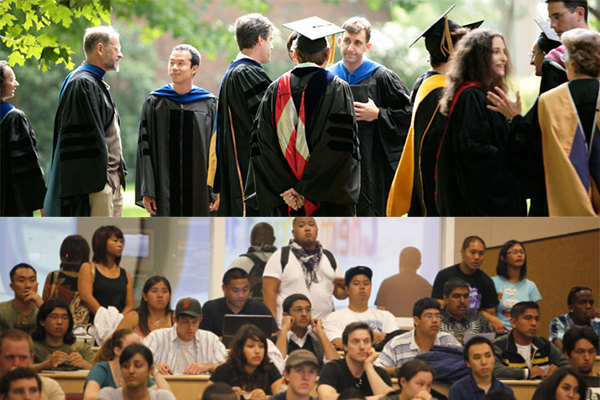Photo by: Will Gentry
From 1987 to the 2011-2012 school year, universities have added staff members at an average rate of 87 a day who neither teach nor conduct research, according to the analysis of federal figures by the New England Center of Investigative Reporting in collaboration with the American Institutes for Research.
Along with the addition of many non-academic administrative staff members, universities have switched from hiring full-time faculty to bringing on part-time adjunct staff members, a supposedly cheaper option for filling classrooms.
Donna Desrochers, a principal researcher at the Delta Cost Project – which studies higher education spending – said in an article by Jon Marcus for the New England Center for Investigative Reporting that these practices aren’t as beneficial as they might appear.
“They’ve increased their hiring of part-time faculty to try and cut costs,” Desrochers said. “Yet other factors that are going on, including the hiring of these other types of non-academic employees, have undercut those savings.”
Some students feel that while part-time adjunct staff may be the cheaper alternative, it may not yield the educational results expected from colleges and universities.
“When you take away full-time positions and tenure, you lose some level of excellence,” senior Jess Tucker said. “These people are supposedly top scholars in their fields, and they’re constantly researching and writing if they’re functioning the way they should, and so when you take that away you’re taking away so much experience from the students.”
Tucker said while part-time faculty may not be a bad thing, they shouldn’t necessarily be the answer for cutting teaching budgets.
“With the idea of introducing adjuncts, there is a possibility of getting a diverse group of faculty – but it’s not guaranteed to be at the level it should be,” Tucker said. “It could work out for the best, but since they’re doing it from an economic standpoint, it’s difficult for me to say it will work out if they are simply looking at numbers.”
Other students such as junior Jamal George echoed Tucker’s opinions.
“It would give students the connotation that being cheaper and taking the easy way out is the way to go, and students may be getting cheated for a better education,” George said. “Making these changes to the classroom dynamics could negatively impact a student’s education for multiple reasons.”
Like some university and college students, other researchers share Desrochers’ concern with the hiring trends amongst colleges and universities.
“There’s just a mind-boggling amount of money per student that’s being spent on administration,” Andrew Gillen, a senior researcher at the Institutes for Research, said in the same article by Jon Marcus. “It raises a question of priorities.”
The vast growth in staff members may not be as black and white an issue as some may think, as there are various contributing factors to this trend not discussed in recent research.
Bill Goad, executive vice president for Oklahoma Christian University, said the amount of faculty in the school depends on the students.
“[Staff growths] are attributed to several things; a growing complexity in higher education is one,” Goad said. “That includes things like technology that 25 years ago didn’t exist. [Another] big issue is the change in what students want; they are coming in with more diverse needs, so we’ve got counselors, academic support people and more Student Life people as well.”
Tucker said more people than ever before are going to college and that’s creating issues.
“I think as a nation, we have a warped sense of education and now we have this [idea that] everyone needs to be highly educated,” Tucker said. “The influx of students and the masses and masses of people who generations ago wouldn’t have gone to college came, and I don’t think we had the facilities to take care of that growth.”
According to Tucker, the growth of administrators was in reaction to the growth of students at colleges and universities – but that increase of administration staff may not be needed anymore.
“There was a panic and I think that’s where this huge mass of non-academic administration may have come from, because they were trying to counter-balance that influx of students,” Tucker said. “Now it’s just a mess that in some cases may need to be stripped back down to simpler means.”
Despite those who oppose the growth of staff members at universities and colleges, there are specific legal and government requirements these institutions have to follow.
While reasonable criticisms towards some universities across the country do exist, Goad explains that Oklahoma Christian has used its best judgment to ensure unnecessary staff members aren’t hired.
“It’s very possible that some higher education institutions have lost their way, getting away from the students,” Goad said. “Here at Oklahoma Christian, our goal has always been to serve the students as much as possible, and we look at every expenditure, not just employees, in a way to see how is that going to serve the students. We don’t hire employees if we don’t have to.”
George expressed that Oklahoma Christian serves the student population well for the price of tuition.
“They do a fair job at keeping tuition down for us students,” George said. “It could always be better, but for what you gain, the connections you make and being around the Christian environment makes it a subtle investment.”












Be First to Comment